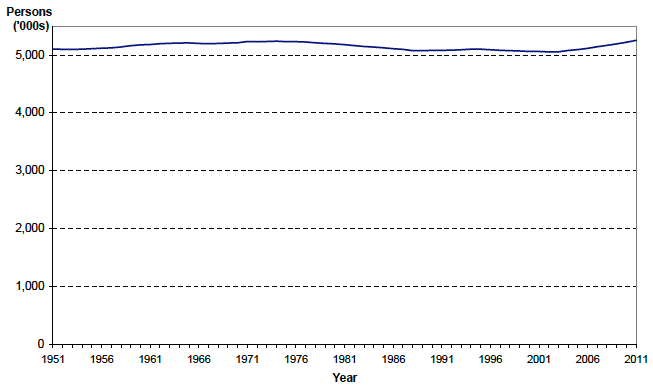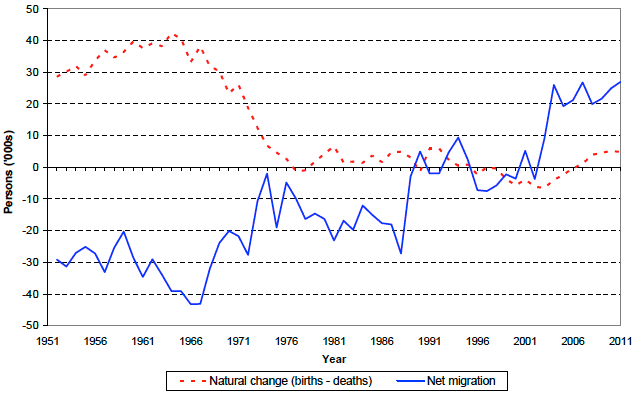
2.1 The estimated population of Scotland on 30 June 2011 was 5,254,800, the highest ever (Figure 1). This represents an increase of 32,700 on the previous year and is 200,000 higher than the estimate for mid-2002, when the population dropped to its lowest level in recent times. In the twelve months to mid-2011, there was a net migration gain of 27,000 people, consisting of a net gain of 2,900 people from the rest of the UK, a net gain of 25,400 from overseas (including asylum seekers) and a net loss of 1,400 due to movements between the armed forces and the civilian population. Other changes (including changes in the prison population, and changes in the number of armed forces stationed in Scotland) amounted to an increase of 900 people. There were 58,766 births in 2010-11 (slightly fewer than the previous year) and 53,957 deaths (slightly more than the previous year). The number of births in the twelve months up to mid-2011 exceeded the number of deaths by 4,809. This compares to a gain of 5,188 in 2009-10.
Figure 1: Estimated population of Scotland, 1951 to 2011

2.2 This is the ninth year in a row that the Scottish population has increased and most of the increase was because more people migrated into Scotland than left.
2.3 In 2010-11 around 43,700 people came to Scotland from England, Wales and Northern Ireland, and 40,800 left Scotland to go in the opposite direction. The resulting net gain of 2,900 was less than the previous year's 3,300 net gain because fewer people came to Scotland.
2.4 The overseas net gain of 25,400 came from an inflow of 42,300 and an outflow of 16,900. This compares with a net in-migration of 21,500 the previous year. Compared to the previous year, slightly fewer people came to Scotland from overseas but many fewer left; in 2009-10 the inflow was 46,100 and the outflow was 24,600. Estimating international migration is particularly difficult. The estimate is based primarily on the International Passenger Survey (IPS) which is a sample survey conducted at main airports and ports across the UK. The sample size for Scotland is very small (around 220 contacts in 2010-11). Internationally, a migrant is defined as someone who changes country of usual residence for 12 months or more, so a short-term seasonal migrant worker will not be counted in the migration estimates or in the mid-year population estimates. More details about the migration data sources and definitions used can be found in Section 5.
2.5 For comparison purposes it is better to look at a time frame of longer than one year, as population change tends to fluctuate from year to year, particularly for smaller areas. Over the last 10 years, between mid-2001 and mid-2011, Scotland's population increased by 3.8 per cent (+190,600) from 5.06 million (Table 6). Figure 2 shows that in recent years migration has been the main reason for population change.
Figure 2: Natural change and net migration, 1951 to 2011

2.6 Table 8 shows movements to and from the UK and overseas between mid-2010 and mid-2011 by age group. The main source of data for the overseas migration calculations is the International Passenger Survey but, because of its small sample size, an age and sex distribution is calculated from General Medical Practitioner (GP) registrations. The method used to estimate international migration is described in Section 5.
2.7 Migrants to Scotland tend to be younger than the general population, as Table 8 shows. Of in-migrants to Scotland, 49 per cent from the rest of the UK and 71 per cent of those from overseas were aged 16-34 years, yet in the resident population only 25 per cent were in this age group. Only 6 per cent of people coming to Scotland from the rest of the UK and 1 per cent of people entering from overseas were aged 65 and over. Scotland had a net gain of UK migrants in every age group, except those aged 25-34, and a net gain of international migrants for all ages under 55.